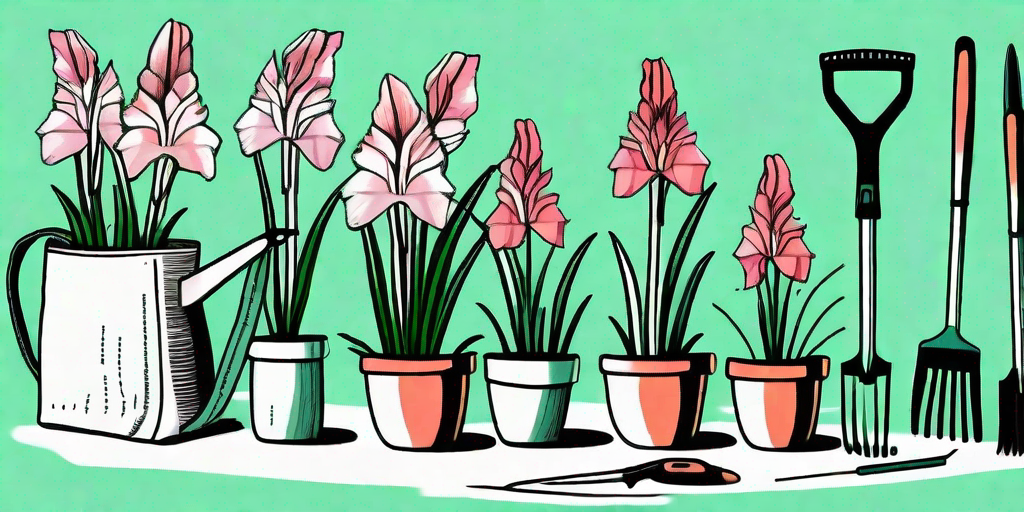
Ah, the gladiolus. A flower so beautiful, it's often the star of the show in any garden. But what happens after the applause dies down and the curtain falls on its blooming performance? Fear not, dear gardener, for we have the answers to your post-blooming gladiolus woes.
Understanding the Gladiolus Life Cycle
Before we dive into the nitty-gritty of post-blooming care, let's take a moment to understand the life cycle of the gladiolus. It's not just a pretty face, you know. This flower has a fascinating life story that would put any soap opera to shame.
The gladiolus, or 'glad' as it's affectionately known, is a perennial that grows from a bulb-like structure called a corm. Each year, the corm sends up a tall spike of flowers that bloom from the bottom up. Once the blooming is over, the plant enters a period of dormancy before the cycle begins again.
The Importance of Dormancy
Now, you might be thinking, "Dormancy? That sounds like a fancy word for laziness." But in the plant world, dormancy is a crucial period of rest and rejuvenation. It's like the plant equivalent of a spa day.
During dormancy, the gladiolus corm stores up energy for the next growing season. This is why it's so important to give your glads the right care during this time. Neglect them now, and they might just decide to sleep in next year.
Post-Blooming Care for Gladiolus
So, how do you pamper your glads during their downtime? Here are some tips to keep them happy and healthy.
Tip #1: Let the Leaves Linger
After the flowers have faded, resist the temptation to tidy up by cutting back the leaves. Those leaves are the gladiolus's solar panels, soaking up sunlight to fuel the corm's energy storage. So let them bask in the sun a while longer.
Once the leaves have turned yellow and withered, it's safe to remove them. By this time, the corm has stored up all the energy it needs.
Tip #2: Keep Them Dry
Gladiolus corms are not fans of soggy conditions. Too much water can lead to rot, which is as unpleasant for plants as it sounds. So, after blooming, cut back on watering.
When the soil is dry to the touch, it's time to water again. But remember, moderation is key. Think of it as a hydration diet for your glads.
Preparing for the Next Blooming Season
With the right post-blooming care, your glads will be raring to go when the next growing season rolls around. But there are a few more steps you can take to ensure a stellar performance.
Step #1: Dig Up the Corms
In colder climates, gladiolus corms need to be dug up and stored indoors over winter. This might seem like a hassle, but think of it as tucking your glads in for a long winter's nap.
Wait until the first frost has blackened the leaves, then carefully dig up the corms. Brush off any soil and let them dry for a few days in a well-ventilated area.
Step #2: Store Them Properly
Once the corms are dry, remove any remaining foliage and store them in a cool, dry place. A paper bag filled with peat moss or sawdust works well.
Check on them occasionally over the winter to make sure they're not rotting or drying out. If they're looking a little shriveled, mist them lightly with water.
Frequently Asked Questions
When should I cut back gladiolus?
Wait until the leaves have turned yellow and withered before cutting them back. This allows the corm to store up energy for the next growing season.
How often should I water gladiolus after blooming?
Cut back on watering after blooming. When the soil is dry to the touch, it's time to water again. But remember, moderation is key.
Do I need to dig up gladiolus corms in winter?
In colder climates, gladiolus corms should be dug up and stored indoors over winter to protect them from freezing temperatures.
How do I store gladiolus corms over winter?
Once the corms are dry, remove any remaining foliage and store them in a cool, dry place. A paper bag filled with peat moss or sawdust works well.
Conclusion
With the right care, your gladiolus can put on a show-stopping performance year after year. So don't neglect them after the curtain falls. Give them the post-blooming care they deserve, and they'll reward you with a garden full of drama and beauty.
Remember, a happy gladiolus is a blooming gladiolus. And a blooming gladiolus is a sight to behold. So here's to many more seasons of spectacular blooms. Curtain up!















